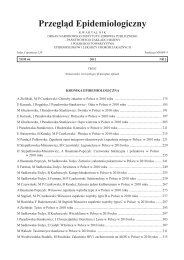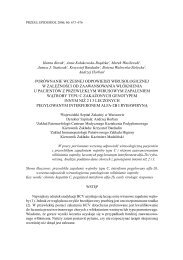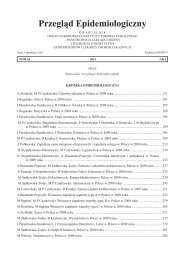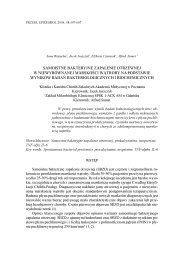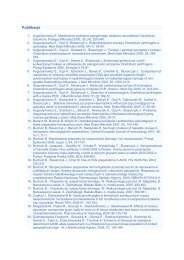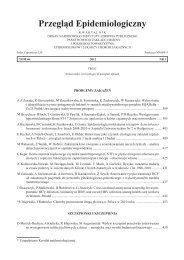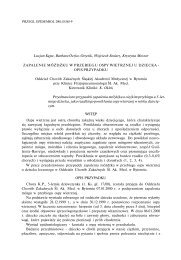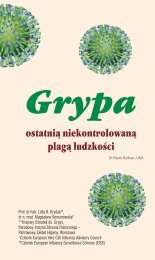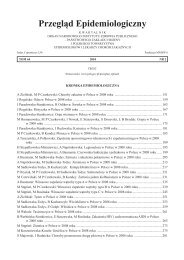Przegląd Epidemiologiczny - Państwowy Zakład Higieny
Przegląd Epidemiologiczny - Państwowy Zakład Higieny
Przegląd Epidemiologiczny - Państwowy Zakład Higieny
You also want an ePaper? Increase the reach of your titles
YUMPU automatically turns print PDFs into web optimized ePapers that Google loves.
Nr 1Consumer behaviour in OTC medicines market 159use OTC drugs (Fig. 1). Statistical analysis highlighteddifferences between analyzed group membership andOTC drugs use frequency (χ 2 =18.35163; p=0.00314).This type of drugs is the most frequently used one(everyday) among medical staff. This fact can be explainedby drug accessibility in respondents’ work places.Drugs availability have direct impact on popularity totake them by medical staff group, while harmless (intheir opinion) symptoms occurs. In turn, 60.0% of respondentsregarded the pharmacist for a person whosesentence can rely on. The important aspect of selectionis considered the drug of its composition (mostly amongthe medical community). Respondents much less suggestthe promotion of pharmaceutical product, or thename of the manufacturer.Analgesics are used by 87.8% of OTC drugs takers.Respondents decide to take analgesics in case of strongpain (pain was assessed at three scales), especiallyamong medical staff (χ 2 =16.45287; p=0.01152). Themost frequent reasons for taking analgesics are: headache69% of respondents, menstrual pain 18% (womenparticipation rates in the study, were almost two timeshigher – it determined the final result). Other reasonsfor taking OTC drugs were: sore throat, stomachache,toothache, injury related pain, and others undefined(Fig. 2).17.9%Fig. 2.Ryc. 2.2.9% 0.7% 1.8%3.3%4.0%69.4%Most common types of pain reported by OTC drugstakersNajczęstsze rodzaje bólu zgłaszane przez respon-Fig. 2. Most common types of pain reported by OTC drugs takersdentów sięgających po leki OTCRyc. 2. Najczęstsze rodzaje bólu zgłaszane przez respondentów sięgających po leki OTCN=400HeadacheMenstrual painSore throatStomach acheToothacheInjuryOthersThe most popular medications contained ibuprofenumlike: ibuprom, ibum, nurofen, etc. mostly amongstudents and non-medical staff. To compare, medicalstaff tends to choose medications containing paracetamolum.Knowledge of OTC drugs composition wasthe highest among medical students and medical staff(χ 2 =39.29904; p=0.00001). Only 30% of respondents,asked about the composition of its analgesic, is aware ofthe active substance in the preparation. More than 70%of the respondents were not familiar with taken OTCdrugs composition, which is an alarming fact. Statisticalanalysis showed that, 90.1% of the studied group readsthe leaflet enclosed to drugs, and 97.4% of respondentsdeclared, that they understand leaflets information.Unfortunately, as the majority of the respondents werenot aware of the pharmaceuticals composition, it canbe assumed that they did not understand leaflet informationcorrectly. Respondents assessed (subjectively)their OTC drugs dosage. The majority, as many as79.5%, believes that they do not overuse OTC drugs.This group was mostly represented by medical studentsand medical staff (Fig. 3). It has to be noticed that alsomedical staff is using OTC drugs the most frequently.Conducted study showed that medically educated andexperienced people deny their actual OTC drugs intake.That fact is disturbing, as people from medical environmentare obliged to serve as an example for peoplewith non-medical background. 50% of the respondentsdo not buy or do not use OTC drugs according to theirgood health and as a consequence they do not needmedications.Only 14% of the respondents were against anytreatments without doctor’s supervision.DISCUSSIONOTC drugs market is one of the fastest growingmarkets in Poland. There was noted a dynamic and fastincrease in drug sales, simultaneously new pharmaceuticalbrands appeared. Poland is the country with one of46.9%N=40040.6%34.4%32.3%28.2%28.1%21.4%18.1%12.5%12.5%12.5%12.5%Overuse 10.3% Don't overuse 79.5% No opinion 10.3%Fig. 3.Ryc. 3.Medical students Non‐medical students Medical staff Non‐medical staffRespondents’ subjective opinion on OTC drugs intakeSubiektywna ocena respondentów dotycząca zażywanej przez nich ilości leków OTCFig. 3. Respondents’ subjective opinion on OTC drugs intakeRyc. 3. Subiektywna ocena respondentów dotycząca zażywanej przez nich ilości leków OTC



